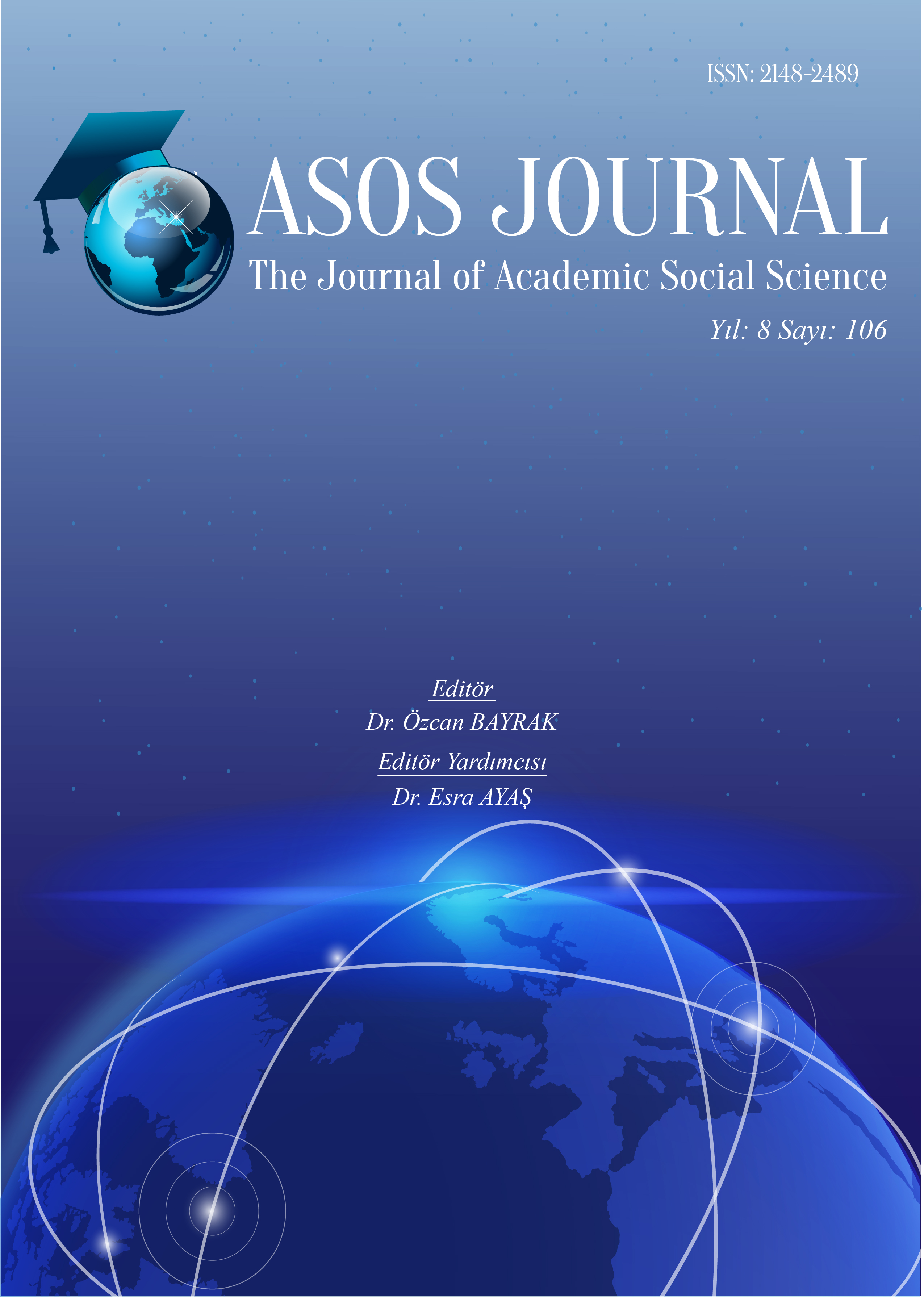LİSANS DÜZEYİNDE MESLEKİ MÜZİK EĞİTİMİ VEREN KURUMLARDA RİTİM ÖĞRETİM YÖNTEMLERİNİN KULLANILMA DURUMLARI
Author :
Abstract
Bu araştırmanın temel amacı, müzik eğitiminde mevcut ritim öğretim yöntemlerinin incelenmesi ve bu yöntemlerin işitme dersi veren öğretim elemanları tarafından kullanım durumlarının saptanmasıdır. Araştırma, durum tespitine yönelik betimsel bir çalışmadır. Veri toplama aracı olarak yarı yapılandırılmış görüşme formu kullanılmıştır. Araştırma sonucunda, 18 öğretim elemanının tamamının ritim öğretim yöntemlerinin gerekliliği hakkında hemfikir olduğu sonucuna ulaşılmıştır. Yöntemlerin öğretim elemanları tarafından tanınırlığının ve derslerde kullanılma durumlarının oldukça düşük olduğu görülmektedir. 14 yöntemden ikisi (Geleneksel yöntem ve Tafatefe) öğretim elemanlarının %50’si tarafından çok iyi düzeyde tanınmaktadır. Diğer yöntemler %60 oranında “hiç” tanınmamaktadır. Sonuç olarak, üniversitelerde ağırlıklı olarak “klasik sayma” yöntemlerinin kullanıldığı belirlenmiştir. “Tafatefe” ve “Geleneksel” ritim öğretim yöntemlerinin en fazla tanınan yöntemler olduğu tespit edilmiştir. Ritim öğretim yöntemlerinin, %86,8 oranı ile işitme derslerinde kullanılmadığı sonucuna ulaşılmıştır.
Keywords
Abstract
The main purpose of this research is to examine the current rhythm teaching methods in music education and to determine the use of these methods by the instructors teaching music theory and hearing. In this study, which is based on a descriptive model, semi-structured interview form was used as data collection tool. As a result of the research, it was concluded that all 18 teaching staff agree on the necessity of rhythm teaching methods. It is seen that the recognition of the methods by the instructors and their use in the lessons are very low. Two of the 14 methods (Traditional method and Tafatefe) are known very well by 50% of the instructors while other methods are not known “at all” at a rate of 60%. As a result, it was found that "counting" methods were used in universities. It was revealed that “Tafatefe” and “Traditional” rhythm teaching methods are the most recognized methods. It is concluded that rhythm teaching methods are not used in hearing lessons with a rate of 86.8%.
Keywords
- Aydoğan, Salih, (2007), Oynayarak Eğlenerek Müzik Dilini Öğreniyoruz. Arkadaş Yayınevi, Ankara.
- Aydoğan, Salih; Özgür, Ülkü, (2005), Müziksel Yazma Eğitimi ve Ezgi Bankası. (1. baskı). Sözkesen Matbaası, Ankara.
- Aydoğan, Salih; Özgür, Ülkü, (2006), Müziksel İşitme Okuma ve Kuram. (4. baskı) Gazi Kitabevi, Ankara.
- Atalay, Adnan, (2009), “Müzik Eğitiminde Ölçü Gruplamalarına Yeni Bir Bakış”, 8. Ulusal Müzik Sempozyumu, 23-25 Eylül 2009, Ondokuz Mayıs Üniversitesi Yayınları, Ondokuz Mayıs Üniversitesi, (131) s. 328-338, Samsun.
- Bebeau, Muriel. J. (1982), “Effects of Traditional and Simplified Methods of Rhythm-Reading Instruction”. Journal of Research in Music Education, 30(2), 107-119.
- Boyle, J. David, (1970), “The Effect of Prescribed Rhythmical Movements on The Ability to Read Music at Sight”. Journal of Research in Music Education, 18(4), 307-318.
- Bulut, Muzaffer, Özgü, (2007), Genç Türk Bestecilerinin Eser Yaratma Süreçlerinde Kullandıkları Ritimsel Elemanlar, Başkent Üniversitesi Sosyal Bilimler Enstitüsü,
- Çalışır, Feridun, (1988), Müzik Teorisi. Kara Kuvvetleri Basımevi ve Evrak Depo Müdürlüğü,
- Dalby, Bruce, (2005), “Toward an Effective Pedagogy for Teaching Rhythm: Gordon and Beyond”. Music Educators Journal, 92(1), 54-60.
- Değer, Atilla, Çağdaş; Aytepe, Çiğdem, (2009), Çocuk Korolarında Temel Müzik Eğitimi 2 (1. baskı), Punto Grafik Tasarım Matbaacılık Hizmetleri, Ankara.
- Demorest, Steven, (2001), Building Choral Excellence: Teaching Sight-Singing in The Choral Rehearsal, Oxford University Press, New York.
- Deutsch, Diana, (1982), The Psychology of Music, Academic Press, Inc., Florida.
- Earney, Megane, Elaine, (2008). The Effects of Aural Rhythmic Dictation on The Sight-Reading Abilities of Seventh and Eighth Grade Band Students, University of Kansas, USA.
- Ester, Don, P.; Scheib, John, W.; Inks, Kimberley, T. (2006), “Takadimi: A Rhythm System for All Ages”, Music Educators Journal, 93, (2).
- Feridunoğlu, Lale, (2004), Müziğe Giden Yol, İnkılap Kitabevi, İstanbul.
- Fust, Tammy, Renee, (2006), Syllable Systems: Four student’s Experinces in Learning Rhythm, University of Louisville, Kentucky.
- Gazimihal, Mahmut, Ragıp, (1961), Musıki Sözlüğü, Milli Eğitim Basımevi, İstanbul.
- Gordon, Edwin, E., (2007), Learning Sequences in Music, GIA Publications, Chicago.
- Gordon, Edwin E., (2009), Rhythm: Contrasting the Implications of Audiation and Notation. GIA Publications, Chicago.
- Hackett, Patricia; Lindeman Carolynn. A. (2004), The Musical Classroom, (6. ed.), Pearson Prentice Hall, USA.
- Hoffman, Richard; Pelto, William, Lyle; White, John, Wesley, (1996), “Takadimi: A Beat- Oriented System of Rhythm Pedagogy”, Journal of Music Theory Pedagogy,10, 10.
- Kalender, Necdet, (2001), “Müzik Dinlemenin Eğitsel Temelleri”, Uludağ Üniversitesi Eğitim Fakültesi Dergisi. 14, (1).
- Károlyi, Otto, (2007), Müziğe Giriş, (Çev., Nemutlu, M.), Pan Yayıncılık, İstanbul.
- Lowder, Jerry, E., (1973), “Evaluation of A Sight-Reading Test Administered to Freshman Piano Classes”, Journal of Research in Music Education, 21(1), 68-73.
- Morgül, Mahiye, (2006), İlk Çocuklukta Müzik Nasıl Öğretilir, Kök Yayıncılık, Ankara.
- O'Donnell, Christian. (2011), An Investigation of The Effect of Instruction in Edwin Gordon's Tonal and Rhythm Patterns on Secondary Students' Advanced Measures of Music Audiation Scores, University of Oklahoma, Oklahoma.
- Özaltunoğlu, Özlem, (2003), Solfej Öğretim Yöntemleri; Dokuz Eylül Üniversitesi, İzmir.
- Özgür, Ülkü. (2000), “Ritim Öğretim Yöntemleri”, Gazi Üniversitesi Gazi Eğitim Fakültesi Dergisi,20, (2).
- Say, Ahmet, (2005), Müzik ansiklopedisi, Müzik Ansiklopedisi Yayınları, Ankara.
- Say, Ahmet, (2002), Müzik Sözlüğü, Müzik Ansiklopedisi Yayınları. Ankara.
- Saygun, Ahmet, Adnan, (1958), Musiki Nazariyatı, Maarif Basımevi, İstanbul.
- Sözer, Vural, (2005), Müzik: Ansiklopedik Sözlük, Remzi Kitabevi, İstanbul.
- Sun, Muammer, (1994), Eğitsel Müzik Öğretimi, Müzik Öğretimi, Müzik Ansiklopedisi Yayınları, Ankara.
- Szönyi, Erzsébet, (1990), Kodaly’s Principles in Practice (Translated by J. Weissman), Corvina, Budapest.
- Uçan. Ali, (2005), Müzik Eğitimi (3. baskı), Evrensel Müzikevi, Ankara.
- Yıldırım, Ali; Şimşek, Hasan, (2000), Sosyal Bilimlerde Nitel Araştırma Yöntemleri, Seçkin Yayınevi, Ankara.





